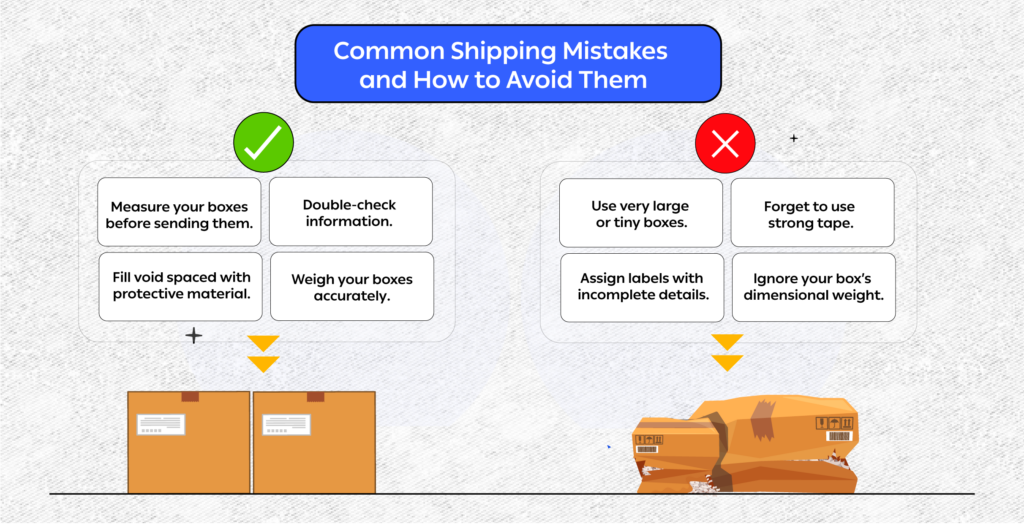E-commerce has revolutionized the way we shop, with apparel leading the charge. By the end of 2024, over 2.7 billion people—33% of the global population—will have made purchases online, marking a 2.7% increase from 2023.
This growth shows no signs of slowing, with projections indicating 2.77 billion online shoppers by 2025 and the fashion eCommerce industry expected to hit $100 billion that same year.
However, while the thrill of new fashion finds is undeniable, shipping clothing presents unique challenges. Ensuring that garments, whether bulky or delicate, arrive in perfect condition requires meticulous planning and execution.
This article dives into the intricacies of shipping clothes, offering invaluable insights and practical tips to streamline the process.
Let’s explore the landscape of shipping clothes and make sure your items arrive just as perfect as when they left.
Understanding the Shipping Landscape for Clothes
The world of fashion is vast and varied, with an incredible range of fabrics, styles, and sizes—all of which demand a strategic approach to shipping. Successfully navigating this landscape requires a deep understanding of the unique characteristics of different garments.
Characteristics of Clothing and Their Impact on Shipping
Clothing is as diverse in its shipping needs as it is in style. Each garment type—whether a lightweight T-shirt, a bulky winter coat, or anything in between—presents specific challenges that must be addressed to ensure safe, efficient delivery. For example:
-
Lightweight T-Shirts:
These garments are straightforward to ship due to their minimal weight and flexible packaging options. They can often be packed in poly mailers or lightweight boxes, requiring only basic protection, like tissue paper, to prevent wrinkling. Their durability during transit typically allows for a more streamlined approach, keeping costs low and efficiency high.
-
Heavy Winter Coats:
In contrast, winter coats are bulky and heavy, necessitating more robust packaging solutions. These items require sturdy boxes and ample padding to protect against potential damage. However, the added weight and size can drive up shipping costs, making it crucial to optimize packing techniques to reduce excess bulk while ensuring adequate protection.
Understanding these nuances is key to mastering cost-effective shipping without compromising garment safety. By tailoring your packaging strategy to the specific needs of each type of clothing, you can streamline the process, reduce costs, and enhance the overall shipping experience.
So, how do you accurately weigh your clothes to determine the best shipping approach? Let’s explore the factors that matter most.
Weight Considerations: Balancing Costs and Protection
The weight of your clothing items plays a significant role in determining shipping costs. Heavier items, like winter coats or bulk orders, can quickly drive up expenses.
To manage these costs, it’s crucial to optimize packing by using the smallest possible box that still provides adequate protection. Compression bags can help reduce volume and weight, further minimizing shipping fees.
However, the need for protection must be balanced with cost efficiency. Even lightweight items should be packed strategically to avoid unnecessary expenses.
Additionally, providing accurate descriptions, especially for international shipments, is vital for smooth customs clearance and avoiding unexpected duties.
How to Accurately Weigh Clothes for Shipping
Properly weighing your clothes before shipping is essential for determining accurate postage costs and avoiding unnecessary fees. It should be a part of optimizing shipping operations, so we advise you to follow this step-by-step guide to ensure precision:
Equipment You’ll Need
- Postal Scale: The most reliable tool for precise measurements, suitable for all package sizes.
- Kitchen Scale: Handy for lighter items, especially when the scale measures in grams or ounces.
- Bathroom Scale: Ideal for heavier packages. For accuracy, weigh the packed item and subtract the packaging weight.
Step-by-Step Weighing Process
- Weigh the Packaging Material:
- Start by weighing the empty packaging (boxes, envelopes, or poly mailers). Knowing this weight is crucial for calculating the total shipment weight.
- Weigh the Packed Item:
- After packing your clothes, weigh the entire package, including both the clothing and the packaging material.
- Calculate the Net Weight:
- Subtract the packaging weight from the total weight to find the net weight of the clothing. This ensures you only pay for what’s necessary and avoid overpayment.
Tips for Accurate Weighing
-
Include All Packing Materials:
- Remember to account for bubble wrap, tissue paper, and other packing materials. Accurate total weight calculations are fundamental to correct postage and the avoidance of surprise fees.
-
Check Carrier Guidelines:
- Different carriers may have specific rules for weight limits and dimensional weight calculations. To prevent additional charges or delays, make sure your package adheres to these guidelines.
-
Round Up for Safety:
- When in doubt, round up the weight to the nearest increment. This small step can save you from unexpected costs during shipping.
By following these steps, you’ll ensure your clothes are weighed accurately, helping you choose the most cost-effective shipping option.
Key Factors to Consider When Shipping Clothes
Shipping clothes involves several crucial factors to ensure a smooth and efficient process. Consider the following elements when making your shipping decisions:
-
Shipping Options
Depending on urgency, you can choose from standard ground shipping, which is cost-effective and ideal for non-urgent deliveries, or expedited services like overnight or two-day shipping for faster delivery.
OTO offers access to over 250 local and international carriers, providing various shipping types to fit different needs. You can build a free account and ship clothes in the UAE starting from 15 AED only without the need for any contracts.
-
Carrier Selection
Evaluate carriers based on delivery speed, tracking options, and handling of delicate items. Obtain quotes from different carriers to find the cheapest way to ship clothes, and consider volume discounts or loyalty programs for regular shippers.
-
Insurance
Protecting your items against loss, damage, or theft is crucial. Most carriers include basic insurance coverage, but additional or third-party insurance might be necessary for higher-value items. This ensures peace of mind and enhances customer satisfaction.
-
Cost Comparison
Compare rates across carriers to find the most economical option. Understand pricing structures to avoid unexpected fees, such as fuel surcharges or handling fees.
For significant savings, use OTO’s shipping rates calculator, which provides access to over 250 carriers and potential discounts of up to 90%.
-
Delivery Speed and Tracking
Match the carrier’s delivery services with your timeline. For fast delivery of clothes, consider real-time tracking and notifications to keep customers informed.
Research each carrier’s reliability and ensure timely and consistent deliveries. OTO’s advanced systems offer detailed tracking information to assist in monitoring shipments.
Shipping Clothes Internationally
Shipping clothes internationally involves additional complexities compared to domestic shipping. Here’s a guide to navigating these challenges effectively:
1. Customs Regulations
- Understand Local Regulations: Each country has unique customs regulations. Familiarize yourself with rules regarding fabric restrictions and required documentation.
- Prepare Required Documentation: Complete paperwork such as commercial invoices, packing lists, and certificates of origin to ensure smooth customs clearance.
- HS Codes: Use accurate Harmonized System (HS) codes to classify goods and determine applicable duties and taxes.
2. Import Duties and Taxes
- Understand Duties and Taxes: International shipments may incur import duties and taxes, typically the recipient’s responsibility. Be aware of these potential costs.
- Estimate Costs: Use duty calculators or consult with customs brokers to estimate duties and taxes, providing accurate customer quotes.
- Inform Recipients: Clearly communicate any potential additional costs to recipients to avoid surprises and ensure they are prepared.
3. Carrier Selection
- International Experience: Select carriers experienced in global logistics and customs procedures. OTO provides access to over 250 international shipping carriers.
- Tracking Services: Opt for carriers with strong tracking capabilities to monitor shipments and address issues promptly.
- Delivery Options: Consider carriers offering various international shipping options, from express to cost-effective solutions.
4. Insurance
- Evaluate Carrier Insurance: Review the primary insurance coverage carriers offer and decide if it’s adequate.
- Purchase Additional Insurance: For valuable or delicate items, consider extra insurance for better protection.
- Third-Party Insurance: Explore third-party options for potentially superior coverage or rates.
By carefully evaluating costs, delivery speed, insurance, and additional services, you can select the right carrier to ensure a smooth and efficient shipping experience, whether locally or internationally.
Common Shipping Mistakes and How to Avoid Them
Ensuring a smooth shipping experience requires meticulous attention to detail. Common mistakes in shipping clothes can lead to unnecessary costs, delays, and even damage. Here’s a comprehensive look at some of the most frequent shipping errors and how to avoid them:
-
Incorrect Box Sizes
Using the wrong box size can have several repercussions. Boxes that are too large may allow clothes to shift during transit, increasing the risk of wrinkles, creases, or even damage. On the other hand, boxes that are too small may force you to cram the clothing, which can lead to deformation or difficulty in sealing the package securely.
How to Avoid It:
- Choose the Right Size: Select boxes that fit the clothing items snugly without excessive empty space. This helps in minimizing movement and ensures the garments remain in their intended shape.
- Measure and Test: Before finalizing your packing, measure the clothing and box dimensions to ensure a good fit. Consider using adjustable box sizes or packing materials that can fill any gaps.
-
Insufficient Padding
Padding is essential for protecting clothes from impacts and potential damage during transit. Insufficient padding can lead to garments being crushed or marked, which is particularly problematic for delicate fabrics or high-value items.
How to Avoid It:
- Use Adequate Materials: Employ cushioning materials such as bubble wrap, packing peanuts, or tissue paper to provide a buffer between the clothing and the box. Ensure that all parts of the clothing are covered, particularly any fragile or embellished sections.
- Fill Void Spaces: Any empty space inside the box should be filled to prevent the items from shifting. This helps maintain the shape and condition of the clothes during transport.
-
Poor Sealing
Proper sealing is crucial for protecting the contents of your package from environmental factors and ensuring it reaches its destination without loss. Poorly sealed packages can result in damage from moisture, dirt, or accidental opening.
How to Avoid It:
- Use Strong Tape: Securely seal all seams and edges of the box with high-quality packing tape. Avoid using flimsy or decorative tapes that may not hold up during transit.
- Reinforce Vulnerable Areas: Pay special attention to the corners and flaps of the box, which are the most vulnerable areas. Reinforce these spots with extra tape if necessary.
-
Incorrect Labeling
Accurate labeling is essential for ensuring your package reaches the correct destination in a timely manner. Incorrect or unclear labels can lead to misdelivery, delays, or even the package being returned.
How to Avoid It:
- Double-Check Information: Verify that all addresses, including recipient details and shipping addresses, are correct and clearly legible. Use a label printer or type out addresses to avoid handwriting issues.
- Include Essential Details: Make sure to include all necessary information, such as contact numbers and any special handling instructions, to aid in smooth delivery and handling.
-
Heavy Packages
Exceeding carrier weight limits can result in additional fees or shipping delays. Properly weighing your packages ensures that you adhere to carrier specifications and avoid unnecessary charges.
How to Avoid It:
- Weigh Accurately: Use a reliable postal scale to weigh both the packed item and the packaging material. Ensure that the total weight falls within the carrier’s limits.
- Consider Dimensional Weight: Be aware of dimensional weight pricing, which is based on the package’s size rather than just its weight. Properly size and pack your box to optimize shipping costs.
Conclusion
Shipping clothes, especially across borders, can be a complex endeavor. However, with careful planning and attention to detail, it can be a seamless process.
By understanding the unique characteristics of different garments, accurately weighing packages, and carefully considering shipping options, you can ensure that your clothes arrive safely and efficiently.
Remember to optimize packaging, choose reliable carriers, and stay informed about customs regulations and potential costs. By avoiding common shipping mistakes and leveraging the resources available, you can streamline the process and deliver your clothes with confidence.







